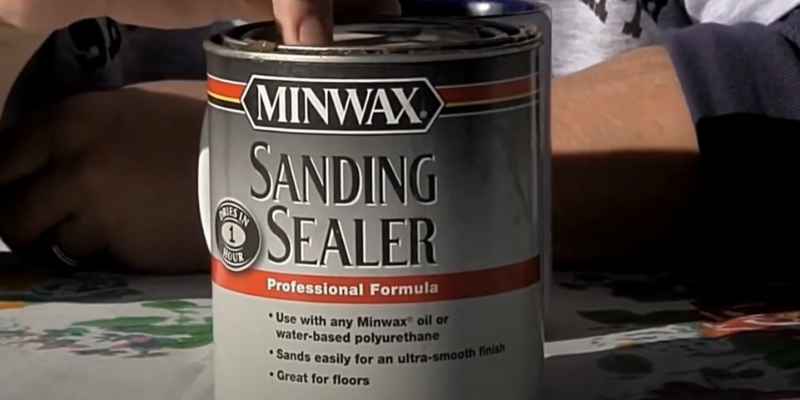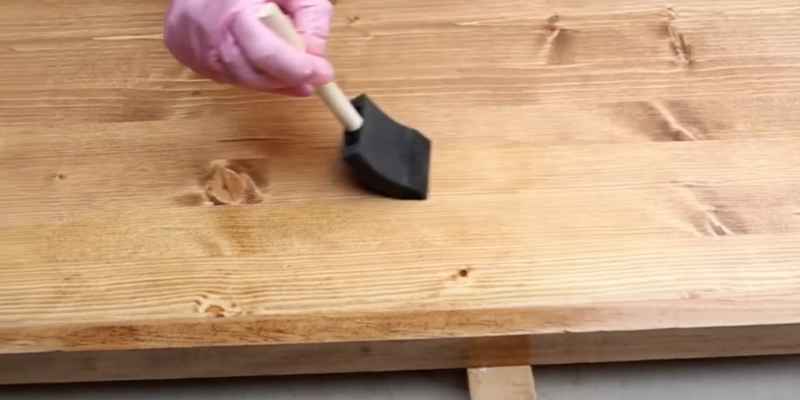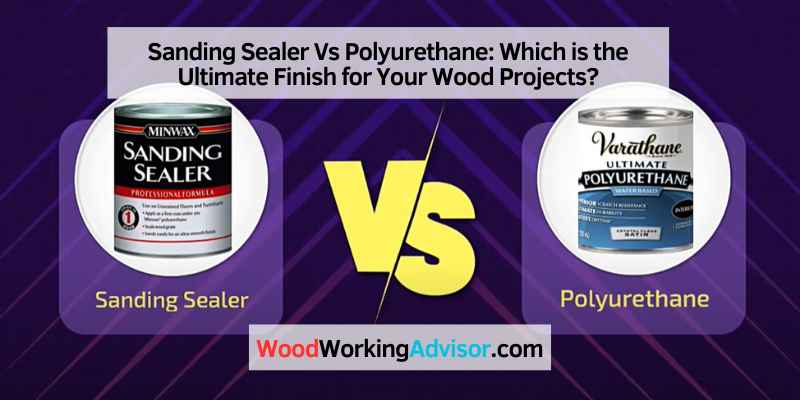Sanding sealer is used to prepare wood surfaces for finishing, while polyurethane is a durable protective coating for wood. In woodworking, sanding sealer is commonly used to seal wood pores and create a smooth surface before applying a topcoat.
On the other hand, polyurethane provides a tough and resilient finish that protects wood surfaces from water, heat, and scratches. Both sanding sealer and polyurethane are essential in achieving a professional and long-lasting finish for woodworking projects.
What Is Sanding Sealer?
A sanding sealer is a coating used to seal wood surfaces before applying a finish. It helps to smooth out imperfections and create a uniform surface. When comparing sanding sealer vs. polyurethane, keep in mind that sanding sealer is designed specifically for pre-finishing purposes, while polyurethane serves as a protective topcoat.
Sanding sealer is a type of primer or sealant that is used in woodworking projects to prepare the surface before applying a final finishing coat like polyurethane. It is applied after the initial sanding of the wood to create a smooth and even surface for the final finish.
Composition And Purpose
Sanding sealer is usually made up of a combination of solvent-borne resins, including lacquer or shellac, which evaporates quickly, leaving a durable and protective layer on the wood. Unlike polyurethane, sanding sealer does not build up on the surface; instead, it penetrates the wood and seals the pores.
Its primary purpose is to prevent the wood from absorbing too much of the final finish, such as polyurethane, which can result in uneven absorption and an inconsistent appearance. Sanding sealer acts as a barrier between the wood and the final finish, ensuring a smooth and flawless application.
Benefits Of Using Sanding Sealer
- Enhances the Appearance: Sanding sealer brings out the natural beauty of the wood by filling in pores, grain, and imperfections, resulting in a smooth and flawless finish.
- Time-Saving: Using sanding sealer reduces the need for excessive sanding and multiple coats of polyurethane, saving both time and effort in the finishing process.
- Improved Durability: The application of sanding sealer creates a protective layer on the wood, enhancing its durability and resistance to scratches, spills, and general wear and tear.
- Reduced Absorption: By sealing the pores of the wood, sanding sealer prevents excessive absorption of polyurethane, ensuring a more consistent and professional-looking finish.
- Easier Application: Sanding sealer provides a smooth and even surface for the application of the final finish, making it easier to achieve a professional-looking result.

What Is Polyurethane?
Polyurethane is a durable and popular finish used to protect and enhance wooden surfaces. Unlike sanding sealer, which provides a smooth base for staining, polyurethane adds a protective layer that can withstand wear and tear. It is often chosen for its long-lasting properties and ability to resist water and chemicals.
Polyurethane is a versatile and durable synthetic material commonly used in a variety of applications, including woodworking. It is a type of finish that is widely preferred for its excellent protective properties and resistance to wear and tear. Understanding the composition and purpose of polyurethane can help you make informed decisions when it comes to woodworking projects. Let’s take a closer look at what polyurethane is all about.
Composition
Polyurethane is made by combining two main components: polyol and isocyanate. These components undergo a chemical reaction to create a liquid substance that can be applied as a coating or finish. The exact composition and formulation of polyurethane can vary depending on the specific application or desired properties. With its unique molecular structure, polyurethane forms a strong and durable protective layer on various surfaces, including wood.
Purpose
The primary purpose of using polyurethane as a finish is to protect the underlying surface from damage and enhance its appearance. When applied to wood, polyurethane creates a hard and resilient barrier that shields the material from moisture, stains, scratches, and UV rays. This makes it an excellent choice for wooden furniture, floors, and decorative items, as it provides long-lasting protection and enhances the natural beauty of the wood. It also serves as a sealant, preventing the wood from absorbing excess moisture and maintaining its stability.
Benefits Of Using Polyurethane
Using polyurethane as a finish offers several benefits that make it an attractive option for woodworking projects:
- Highly durable: Polyurethane creates a tough and resilient finish that can withstand heavy use and frequent handling without wearing down easily.
- Protection against damage: The protective properties of polyurethane shield the wood from moisture, stains, scratches, and other potential damages, prolonging its lifespan.
- Enhanced aesthetics: Polyurethane enhances the natural color and grain of the wood, giving it a beautiful and polished look.
- Easy maintenance: Polyurethane finishes are relatively low-maintenance, as they can be easily cleaned with mild soap and water.
- Versatility: Polyurethane is compatible with various wood types and can be applied to different surfaces, including furniture, floors, and wooden decor.
- UV protection: Polyurethane provides a layer of defense against harmful UV rays, preventing the wood from fading or discoloring over time.
In conclusion, polyurethane is a popular finish for woodworking projects due to its durable and protective nature. Its composition and purpose allow it to form a strong barrier that safeguards wood from various forms of damage while enhancing its appearance. The numerous benefits of using polyurethane as a finish make it an ideal choice for those looking to protect and preserve their wooden creations for years to come.
Differences Between Sanding Sealer And Polyurethane
When deciding on the best finish for your woodworking project, it’s important to understand the differences between sanding sealer and polyurethane. Both serve as protective coatings for wood, but they have distinct characteristics that make them suitable for different applications. In this article, we will explore the application process, appearance and sheen, and durability and protection offered by each option.
Application Process
Sanding sealer and polyurethane differ in terms of their application process. Sanding sealer is typically applied as a preliminary step before applying the final finish. This sealer is formulated to penetrate the wood’s pores, filling them in and creating a smooth and level surface. Once the sealer dries, it is sanded down to promote adhesion for the subsequent finish coats. On the other hand, polyurethane is a topcoat that is applied directly onto the sealed or unsealed wood surface. It comes in various forms such as spray, brush-on, or wipe-on, allowing for flexibility depending on the project requirements.
Appearance And Sheen
When it comes to appearance, both sanding sealer and polyurethane can enhance the beauty of wood. However, they offer different sheens and aesthetics. Sanding sealer typically dries to a dull or matte finish, which is ideal for projects where a natural and rustic look is desired. On the other hand, polyurethane is available in different sheens such as glossy, satin, or matte. This allows you to achieve the desired level of shine and smoothness for your project. Whether you prefer a high-gloss finish or a more subtle sheen, polyurethane provides options to suit your preferences.
Durability And Protection
When it comes to durability and protection, polyurethane takes the lead. This topcoat is known for its excellent resistance to scratches, water, and UV damage. It forms a hard protective barrier that shields the wood from everyday wear and tear, making it suitable for high-traffic areas or outdoor applications. Sanding sealer, on the other hand, provides limited protection and is better suited for indoor or low-impact projects. It helps seal the wood and increase the lifespan of the finish by preventing stain bleed-through and minimizing sanding scratches.
In conclusion, the choice between sanding sealer and polyurethane depends on your specific woodworking project requirements. If you’re looking for a preliminary coating that offers minimal protection and a natural finish, sanding sealer is the way to go. However, if you prioritize durability, protection, and the ability to customize the sheen level, polyurethane is the ideal choice.
Which Finish To Choose For Your Wood Projects?
Which Finish to Choose for Your Wood Projects?
When it comes to completing your wood projects, choosing the right finish is crucial. Two popular options that often come up in this decision-making process are sanding sealer and polyurethane. But how do you decide which one to choose? In this article, we will explore the considerations and specific project requirements that can help you make an informed decision.
Consideration Factors
Before making a decision between sanding sealer and polyurethane, there are several factors to consider. Understanding these factors can help you determine the best finish for your wood projects. Let’s take a look at each one:
- Wood type: Consider the type of wood you are working with. Some woods, such as pine or cedar, may require a different type of finish compared to hardwoods like oak or mahogany.
- Desired appearance: Think about the final look you want to achieve. Sanding sealer tends to enhance the natural color and grain of the wood, while polyurethane can provide a more durable and glossy finish.
- Application process: Consider the ease of application. Sanding sealer typically requires fewer coats and can be easily applied with a brush or spray gun. On the other hand, polyurethane may require multiple coats and more time for drying between each coat.
- Protection and durability: Evaluate the level of protection and durability needed for your project. Polyurethane is known for its excellent resistance to scratches, stains, and moisture, making it suitable for high-traffic areas or objects that will be frequently used.
- Time constraints: Take into account any time constraints you may have. Sanding sealer usually dries faster, allowing you to work on subsequent layers sooner. Polyurethane, however, requires longer drying times, which may extend the overall project timeline.
Specific Project Requirements
Once you have considered the general factors mentioned above, it’s also important to assess the specific requirements of your project. Here are a few scenarios where one finish may be more suitable than the other:
| Project Scenario | Ideal Finish |
|---|---|
| Furniture for a busy household | Polyurethane |
| A decorative wooden bowl | Sanding sealer |
| Exterior wooden signage | Polyurethane |
| A wooden cutting board | Sanding sealer |
Remember, these are just examples, and the best finish for your specific project will ultimately depend on its unique requirements.
By considering the factors mentioned above and understanding the specific project requirements, you can confidently choose between sanding sealer and polyurethane for your wood projects. Whether you prioritize protection, durability, or appearance, selecting the right finish will play a significant role in the overall success and longevity of your woodworking endeavors.

Frequently Asked Questions On Sanding Sealer Vs Polyurethane
Should I Use Sanding Sealer Before Polyurethane?
Yes, using sanding sealer before applying polyurethane is recommended. Sanding sealer provides a smooth surface for the polyurethane to adhere to, enhancing the overall finish. It also helps seal wood pores and improves stain absorption, resulting in a more even and professional-looking final coat.
What Is The Purpose Of Sanding Sealer?
Sanding sealer is used to prepare wood surfaces for finishing by sealing the pores and creating a smooth and even surface. It helps to prevent the finish from being absorbed unevenly and enhances the overall appearance of the final coat.
Can Sanding Sealer Be Used As A Top Coat?
Yes, sanding sealer can be used as a top coat. It provides a smooth surface for painting or staining and helps the top coat adhere better.
What Can Be Used As Sanding Sealer?
Common materials such as shellac, lacquer, or water-based sealers can be used as sanding sealers.
Conclusion
To sum up, choosing between sanding sealer and polyurethane will depend on your specific project requirements. Sanding sealer is a great option for enhancing the natural beauty of wood, providing a smooth base for further coatings. On the other hand, polyurethane offers superior durability and protection against wear and tear.
Consider your desired finish, level of protection, and the amount of maintenance required to make an informed decision. Always test the products on a small area before applying them to the entire surface.


